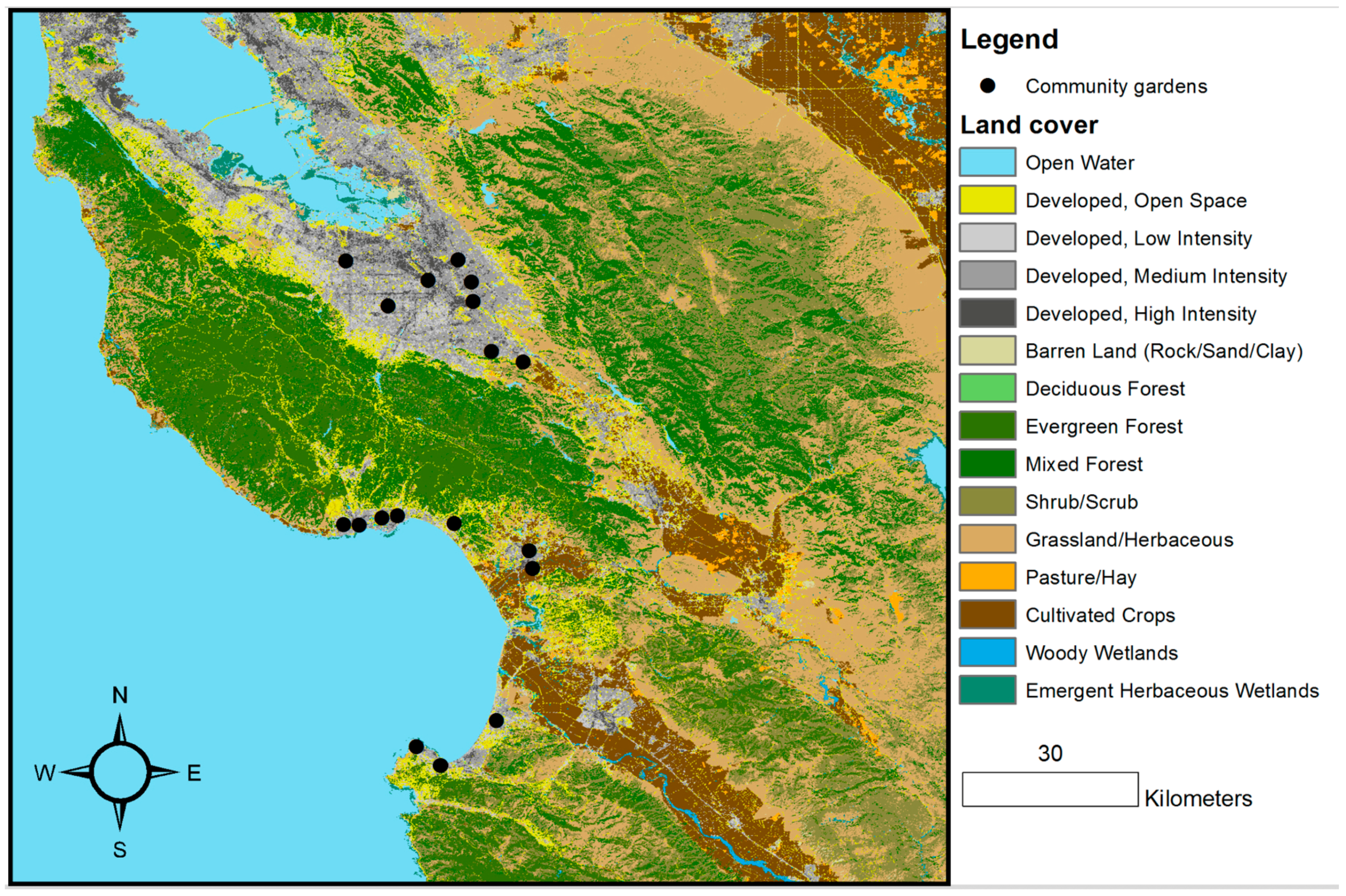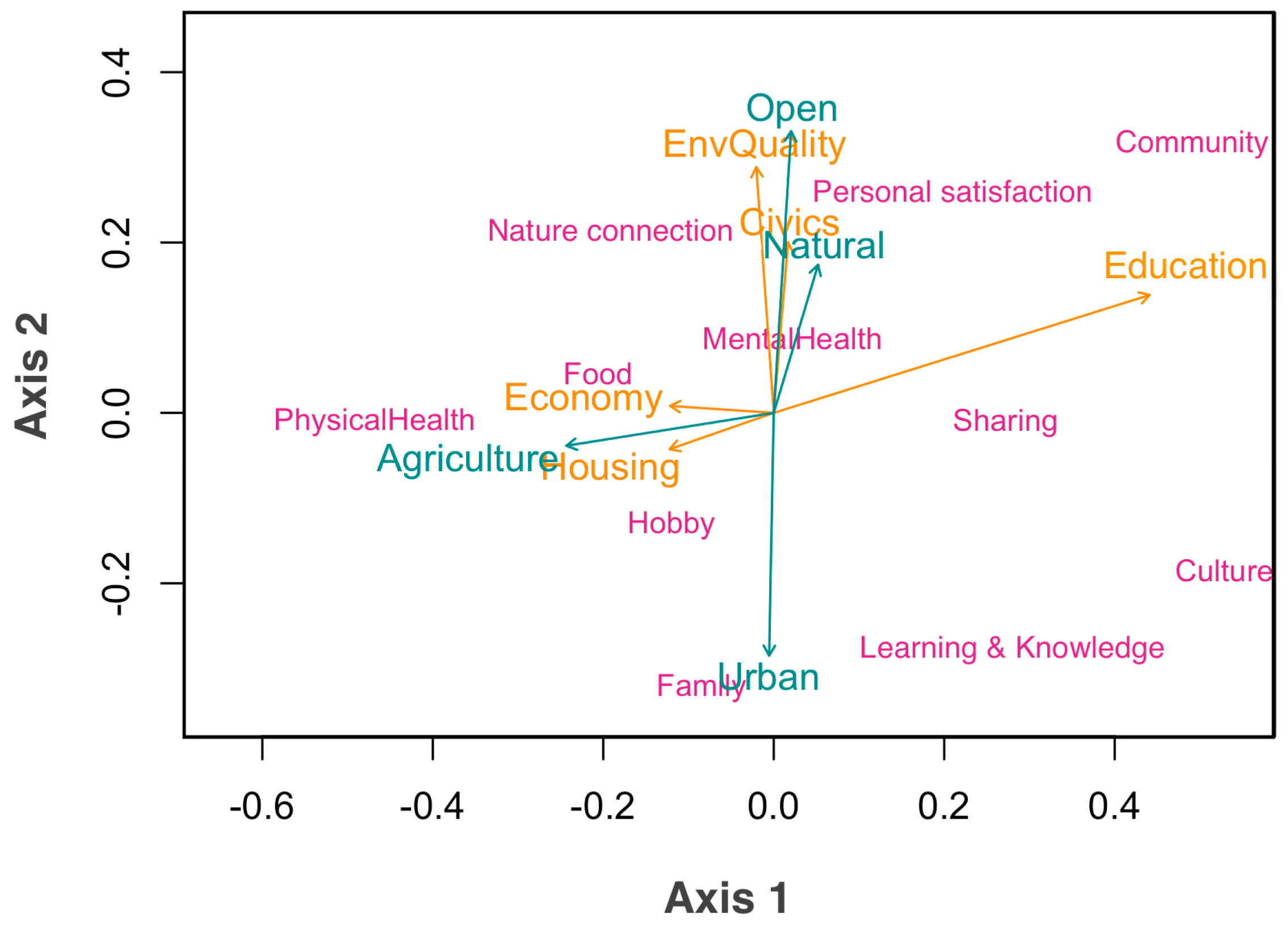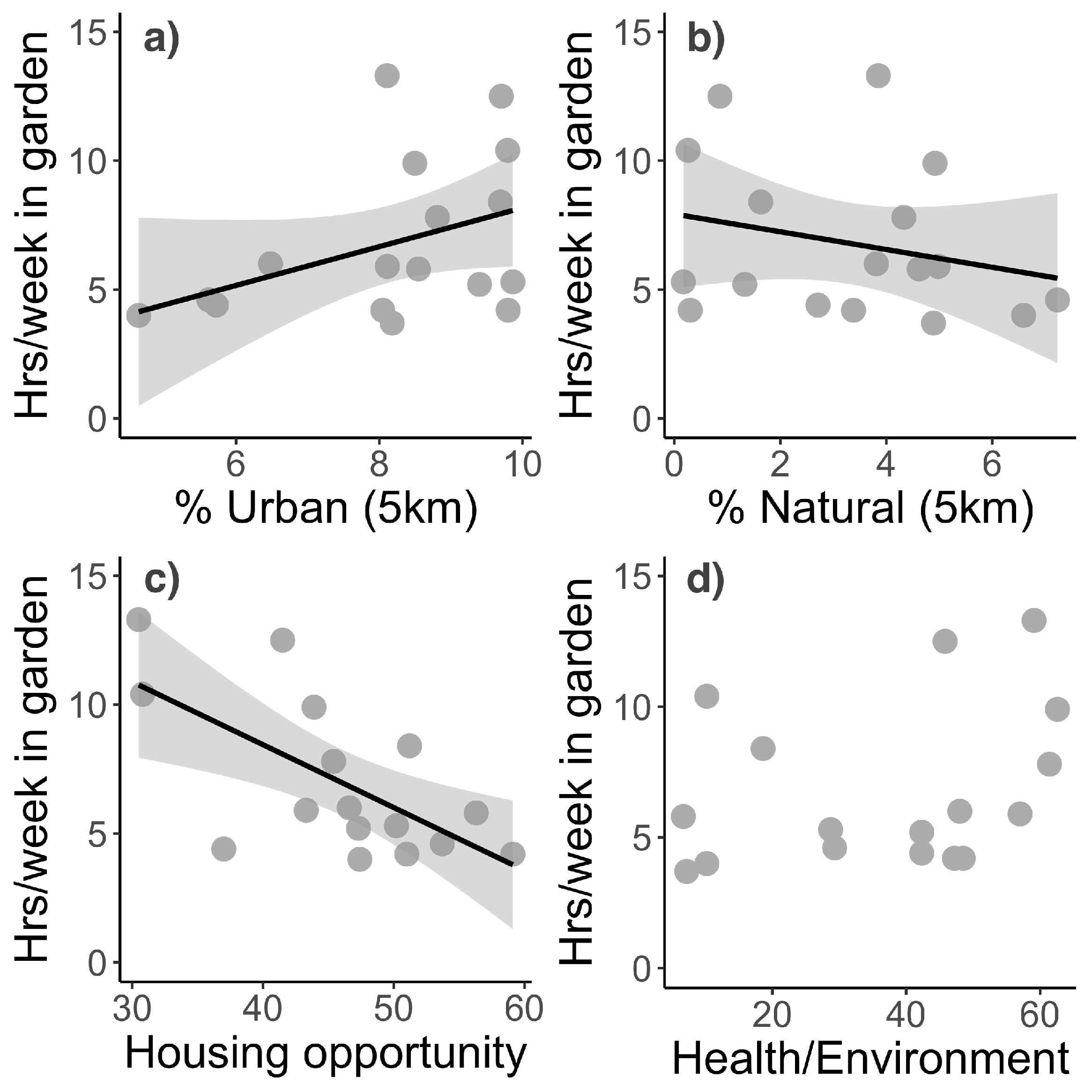Gardener Well-Being along Social and Biophysical Landscape Gradients
Abstract
1. Introduction
2. Materials and Methods
2.1. Study System
2.2. Neighborhood Biophysical and Social Opportunity Data
2.3. Community Gardener Data
2.4. Data Analysis
3. Results
3.1. Self-Reported Well-Being
3.2. Self-Reported Garden Use
4. Discussion
5. Conclusions
Supplementary Materials
Acknowledgments
Author Contributions
Conflicts of Interest
References
- Grimm, N.B.; Faeth, S.H.; Golubiewski, N.E.; Redman, C.L.; Wu, J.; Bai, X.; Briggs, J.M. Global change and the ecology of cities. Science 2008, 319, 756–760. [Google Scholar] [CrossRef] [PubMed]
- Stocker, T.F.; Qin, D.; Plattner, G.-K.; Alexander, L.V.; Allen, S.K.; Bindoff, N.L.; Bréon, F.-M.; Church, J.A.; Cubasch, U.; Emori, S.; et al. Technical Summary. In Climate Change 2013: The Physical Science Basis; Contribution of Working Group I to the Fifth Assessment Report of the Intergovernmental Panel on Climate Change; Cambridge University Press: Cambridge, UK, 2013; pp. 33–115. [Google Scholar] [CrossRef]
- Kleerekoper, L.; Van Esch, M.; Salcedo, T.B. How to make a city climate-proof, addressing the urban heat island effect. Resour. Conserv. Recycl. 2012, 64, 30–38. [Google Scholar] [CrossRef]
- Gill, S.E.; Handley, J.F.; Ennos, A.R.; Pauleit, S. Adapting cities for climate change: The role of the green infrastructure. Built Environ. 2007, 33, 115–133. [Google Scholar] [CrossRef]
- Alexandri, E.; Jones, P. Temperature decreases in an urban canyon due to green walls and green roofs in diverse climates. Build. Environ. 2008, 43, 480–493. [Google Scholar] [CrossRef]
- Hartig, T.; Mitchell, R.; de Vries, S.; Frumkin, H. Nature and health. Annu. Rev. Public Health 2014, 35, 207–228. [Google Scholar] [CrossRef] [PubMed]
- Lee, A.C.K.; Maheswaran, R. The health benefits of urban green spaces: A review of the evidence. J. Public Health 2011, 33, 212–222. [Google Scholar] [CrossRef] [PubMed]
- Mitchell, R.; Popham, F. Effect of exposure to natural environment on health inequalities: An observational population study. Lancet 2008, 372, 1655–1660. [Google Scholar] [CrossRef]
- Jennings, V.; Gaither, C.J. Approaching environmental health disparities and green spaces: An ecosystem services perspective. Int. J. Environ. Res. Public Health 2015, 12, 1952–1968. [Google Scholar] [CrossRef] [PubMed]
- Rook, G.A. Regulation of the immune system by biodiversity from the natural environment: An ecosystem service essential to health. Proc. Natl. Acad. Sci. USA 2013, 110, 18360–18367. [Google Scholar] [CrossRef] [PubMed]
- Hanski, I.; Von Hertzen, L.; Fyhrquist, N.; Koskinen, K.; Torppa, K.; Laatikainen, T.; Karisola, P. Environmental biodiversity, human microbiota, and allergy are interrelated. Proc. Natl. Acad. Sci. USA 2012, 109, 8334–8339. [Google Scholar] [CrossRef] [PubMed]
- World Health Organization. Wellbeing Measures in Primary Health Care/The Depcare Project: Report on a WHO Meeting, Stockholm, Sweden, 12–13 February 1998. Available online: http://www.euro.who.int/__data/assets/pdf_file/0016/130750/E60246.pdf (accessed on 30 November 2017).
- Arnberger, A.; Allex, B.; Eder, R.; Ebenberger, M.; Wanka, A.; Kolland, F.; Wallner, P.; Hutter, H.P. Elderly resident’s uses of and preferences for urban green spaces during heat periods. Urban For. Urban Green. 2017, 21, 102–115. [Google Scholar] [CrossRef]
- Mees, H.L.P.; Driessen, P.P.J.; Runhaar, H.A.C. “Cool” governance of a “hot” climate issue: Public and private responsibilities for the protection of vulnerable citizens against extreme heat. Reg. Environ. Chang. 2015, 15, 1065–1079. [Google Scholar] [CrossRef]
- Lin, B.B.; Meyers, J.; Barnett, G. Understanding the potential loss and inequities of green space distribution with urban densification. Urban For. Urban Green. 2015, 14, 952–958. [Google Scholar] [CrossRef]
- Pauleit, S.; Ennos, R.; Golding, Y. Modeling the environmental impacts of urban land use and land cover change—A study in Merseyside, UK. Landsc. Urban Plan. 2005, 71, 295–310. [Google Scholar] [CrossRef]
- Heynen, N.; Perkins, H.A.; Roy, P. The political ecology of uneven urban green space: The impact of political economy on race and ethnicity in producing environmental inquality in MIlwaukee. Urban Aff. Rev. 2006, 42, 3–25. [Google Scholar] [CrossRef]
- Wen, M.; Zhang, X.; Croft, J.B. Spatial disparities in the distribution of parks and green spaces in the USA. Annu. Behav. Med. 2013, 45, 18–27. [Google Scholar] [CrossRef] [PubMed]
- Boone, C.G.; Buckley, G.L.; Grove, J.M.; Sister, C. Parks and people: An environmental justice inquiry in Baltimore, Maryland. Ann. Am. Assoc. Geogr. 2009, 99, 767–787. [Google Scholar] [CrossRef]
- Tooke, T.R.; Klinkenberg, B.; Coops, N.C. A geographical approach to identifying vegetation-related environmental equity in Canadian cities. Environ. Plan. B Plan. Des. 2010, 37, 1040–1056. [Google Scholar] [CrossRef]
- Astell-burt, T.; Feng, X.; Mavoa, S.; Badland, H.M.; Giles-corti, B. Do low-income neighbourhoods have the least green space? A cross-sectional study of Australia’s most populous cities. BMC Public Health 2014, 14, 19–21. [Google Scholar] [CrossRef] [PubMed]
- Jennings, V.; Floyd, M.F.; Shanahan, D.; Coutts, C.; Sinykin, A. Emerging issues in urban ecology: Implications for research, social justice, human health, and well-being. Popul. Environ. 2017, 39, 69–86. [Google Scholar] [CrossRef]
- Kingsley, J.Y.; Townsend, M.; Henderson-Wilson, C. Cultivating health and wellbeing: Members’ perceptions of the health benefits of a Port Melbourne community garden. Leis. Stud. 2009, 28, 207–219. [Google Scholar] [CrossRef]
- Guitart, D.; Pickering, C.; Byrne, J. Past results and future directions in urban community gardens research. Urban For. Urban Green. 2012, 11, 364–373. [Google Scholar] [CrossRef]
- Alaimo, K.; Packnett, E.; Miles, R.A.; Kruger, D.J. Fruit and vegetable intake among urban community gardeners. J. Nutr. Educ. Behav. 2008, 40, 94–101. [Google Scholar] [CrossRef] [PubMed]
- Wakefield, S.; Yeudall, F.; Taron, C.; Reynolds, J.; Skinner, A. Growing urban health: Community gardening in South-East Toronto. Health Promot. Int. 2007, 22, 92–101. [Google Scholar] [CrossRef] [PubMed]
- Armstrong, D. A survey of community gardens in upstate New York: Implications for health promotion and community development. Health Place 2000, 6, 319–327. [Google Scholar] [CrossRef]
- Wood, C.J.; Pretty, J.; Griffin, M. A case—Control study of the health and well-being benefits of allotment gardening. J. Public Health 2016, 38, e336–e344. [Google Scholar] [CrossRef] [PubMed]
- Kingsley, J.Y.; Townsend, M. “Dig In” to social capital: Community gardens as mechanisms for growing urban social connectedness. Urban Policy Res. 2006, 24, 525–537. [Google Scholar] [CrossRef]
- Glover, T.D.; Parry, D.C.; Shinew, K.J. Building relationships, accessing resources: Mobilizing social capital in community garden contexts. J. Leis. Res. 2005, 37, 450–474. [Google Scholar]
- Bell, S.; Fox-Kämper, R.; Keshavarz, N.; Benson, M.; Caputo, S.; Noori, S.; Voigt, A. Urban Allotment Gardens in Europe; Routledge: London, UK, 2016. [Google Scholar]
- Beilin, R.; Hunter, A. Co-constructing the sustainable city: How indicators help us “grow” more than just food in community gardens. Local Environ. 2011, 16, 523–538. [Google Scholar] [CrossRef]
- Teig, E.; Amulya, J.; Bardwell, L.; Buchenau, M.; Marshall, J.A.; Litt, J.S. Collective efficacy in Denver, Colorado: Strengthening neighborhoods and health through community gardens. Health Place 2009, 15, 1115–1122. [Google Scholar] [CrossRef] [PubMed]
- Cohen, N.; Reynolds, K. Resource needs for a socially just and sustainable urban agriculture system: Lessons from New York City. Renew. Agric. Food Syst. 2014, 30, 103–114. [Google Scholar] [CrossRef]
- Reynolds, K.; Cohen, N. Beyond the Kale: Urban Agriculture and Social Justice Activism in New York City; University of Georgia Press: Athens, GA, USA, 2016; Volume 28. [Google Scholar]
- Sullivan, W.C.; Kuo, F.E.; DePooter, S.F. The fruit of urban nature: Vital neighborhood spaces. Environ. Behav. 2004, 36, 678–700. [Google Scholar] [CrossRef]
- McWilliams, C. California: The Great Exception; University of California Press: Berkeley, CA, USA, 1999. [Google Scholar]
- Greenberg, M.; McKay, S. No Place Like Home; University of California, Santa Cruz: Santa Cruz, CA, USA, 2017; Available online: http://noplacelikehomeucsc.org/en/ (accessed on 1 December 2017).
- Parks, Recreation & Neighborhood Services, C. of S.J. Community Garden Plots. Available online: http://www.sanjoseca.gov/index.aspx?NID=599 (accessed on 5 November 2017).
- Brown, S.; Getz, C. Farmworker food insecurity and the production of hunger in California. In Cultivating Food Justice: Race, Class, and Sustainability (Food, Health, and the Environment); Alkon, A.H., Agyeman, J., Eds.; The MIT Press: Cambridge, MA, USA, 2011; pp. 121–146. [Google Scholar]
- Norkunas, M.K. The Politics of Public Memory: Tourism, History, and Ethnicity in Monterey, California; SUNY Press: Albany, NY, USA, 1993. [Google Scholar]
- Pellow, D.N.; Park, L.S.-H. The Silicon Valley of Dreams: Environmental Injustice, Immigrant Workers, and the High-Tech Global Economy; NYU Press: New York, NY, USA, 2002; ISBN 0814768172. [Google Scholar]
- Jin, S.; Yang, L.; Danielson, P.; Homer, C.; Fry, J.; Xian, G. A comprehensive change detection method for updating the National Land Cover Database to circa 2011. Remote Sens. Environ. 2013, 132, 159–175. [Google Scholar] [CrossRef]
- Environmental Systems Research Institute. ESRI ArcGIS Desktop: Release 10; Environmental Systems Research Institute: Redlands, CA, USA, 2010. [Google Scholar]
- Homer, C.G.; Dewitz, J.A.; Yang, L.; Jin, S.; Danielson, P.; Xian, G.; Coulston, J.; Herold, N.D.; Wickham, J.D.; Megown, K. Completion of the 2011 National Land Cover Database for the conterminous United States-Representing a decade of land cover change information. Photogramm. Eng. Remote Sens. 2015, 81, 345–354. [Google Scholar] [CrossRef]
- Cadenasso, M.L.; Pickett, S.T.A.; Schwarz, K.; Cadenassol, M.L.; Pickett, S.T.A.; Schwarz, K. Spatial heterogeneity in urban ecosystems: Reconceptualizing land cover and a framework for classification. Front. Ecol. Environ. 2007, 5, 80–88. [Google Scholar] [CrossRef]
- Center for Regional Change. Regional Opportunity Index; Center for Regional Change: Davis, CA, USA, 2015. [Google Scholar]
- United States Census Bureau. American Community Survey Data; United States Census Bureau: Suitland, MD, USA, 2014. Available online: http://factfinder.census.gov (accessed on 2 January 2018).
- Power, A.; Smyth, K. Heritage, health and place: The legacies of local community-based heritage conservation on social wellbeing. Health Place 2016, 39, 160–167. [Google Scholar] [CrossRef] [PubMed]
- Millennium Ecosystem Assessment. Ecosystems and Human Well-Being: Synthesis; Millennium Ecosystem Assessment: Washington, DC, USA, 2005; Volume 5. [Google Scholar]
- Lieber, E.; Weisner, T.; Taylor, J. Dedoose Software; Sociocultural Research Consultants: California, CA, USA, 2011. [Google Scholar]
- Oksanen, J. Multivariate Analysis of Ecological Communities in R; Vegan Tutorial; University Oulu: Oulu, Finland, 2015; pp. 1–40. [Google Scholar] [CrossRef]
- R Team. R Development Core Team. RA Lang. Environ. Stat. Comput. 2013, 55, 275–286. [Google Scholar]
- Calcagno, V.; Mazancourt, C. De glmulti: An R Package for easy automated model selection with (generalized) linear models. J. Stat. Softw. 2010, 34, 1–29. [Google Scholar] [CrossRef]
- Breheny, P.; Burchett, W. Visualizing Regression Models Using Visreg. 2012. Available online: http://myweb.uiowa.edu/pbreheny/publications/visreg.pdf (accessed on 13 November 2017).
- Algert, S.J.; Baameur, A.; Renvall, M.J. Vegetable output and cost savings of community gardens in San Jose, California. J. Acad. Nutr. Diet. 2014, 114, 1072–1076. [Google Scholar] [CrossRef] [PubMed]
- Tzoulas, K.; Korpela, K.; Venn, S.; Yli-pelkonen, V.; Ka, A.; Niemela, J.; James, P. Promoting ecosystem and human health in urban areas using green infrastructure: A literature review. Landsc. Urban Plan. 2007, 81, 167–178. [Google Scholar] [CrossRef]
- Firth, C.; Maye, D.; Pearson, D. Developing “community” in community gardens. Local Environ. 2011, 16, 555–568. [Google Scholar] [CrossRef]
- Gichunge, C.; Kidwaro, F. Utamu wa Afrika (the sweet taste of Africa): The vegetable garden as part of resettled African refugees’ food environment. Nutr. Diet. 2014, 71, 270–275. [Google Scholar] [CrossRef]
- Krasny, M.E.; Tidball, K.G. Community gardens as contexts for science, stewardship, and civic action learning. Cities Environ. 2009, 2, 1–18. [Google Scholar] [CrossRef]
- Okvat, H.A.; Zautra, A.J. Community gardening: A parsimonious path to individual, community, and environmental resilience. Am. J. Community Psychol. 2011, 47, 374–387. [Google Scholar] [CrossRef] [PubMed]
- Lin, B.B.; Gaston, K.J.; Fuller, R.A.; Wu, D.; Bush, R.; Shanahan, D.F. How green is your garden?: Urban form and socio-demographic factors influence yard vegetation, visitation, and ecosystem service benefits. Landsc. Urban Plan. 2017, 157, 239–246. [Google Scholar] [CrossRef]
- Saldivar-Tanaka, L.; Krasny, M.E. Culturing community development, neighborhood open space, and civic agriculture: The case of Latino community gardens in New York City. Agric. Hum. Values 2004, 21, 399–412. [Google Scholar] [CrossRef]
- Baker, L.E. Tending cultural landscapes and food citizenship in Toronto’s community gardens. Geogr. Rev. 2004, 94, 305–325. [Google Scholar] [CrossRef]
- Campbell, L.; Wiesen, A. Restorative Commons: Creating Health and Well-Being through Urban Landscapes; Department of Agriculture, Forest Service, Northern Research Station: Newtown Square, PA, USA, 2011. [Google Scholar]
- Blunsdon, B.; Davern, M. Measuring wellness through interdisciplinary community development: Linking the physical, economic and social environment. J. Community Pract. 2007, 15, 217–238. [Google Scholar] [CrossRef]
- Florida, R. The New Urban Crisis: How Our Cities Are Increasing Inequality, Deepening Segregation, and Failing the Middle Class—And What We Can Do about It; Basic Books: New York, NY, USA, 2017. [Google Scholar]
- Eigenbrod, F.; Bell, V.A.; Davies, H.N.; Heinemeyer, A.; Armsworth, P.R.; Gaston, K.J. The impact of projected increases in urbanization on ecosystem services. Proc. R. Soc. B Biol. Sci. 2011. [Google Scholar] [CrossRef] [PubMed]
- Flocks, J.; Escobedo, F.; Wade, J.S.; Varela, S.; Wald, C. Environmental justice implications of urban tree cover in Miami-Dade County, Florida. Environ. Justics 2011, 4, 125–134. [Google Scholar] [CrossRef]
- Jenerette, G.D.; Harlan, S.L.; Stefanov, W.L.; Martin, C.A. Ecosystem services and urban heat riskscape moderation: Water, green spaces, and social inequality in Phoenix, USA. Ecol. Appl. 2011, 21, 2637–2651. [Google Scholar] [CrossRef] [PubMed]
- Middle, I.; Dzidic, P.; Buckley, A.; Bennett, D.; Tye, M.; Jones, R. Integrating community gardens into public parks: An innovative approach for providing ecosystem services in urban areas. Urban For. Urban Green. 2012, 13, 638–645. [Google Scholar] [CrossRef]



| Opportunity Domain | Neighborhood Assessment | ACS Indicators |
|---|---|---|
| Economy | Neighborhood job and business climate | Job Availability (#), Job Quality (%), Job Growth (%), Bank Accessibility (#), Business Growth (%) |
| Housing | Neighborhood availability of sufficient and affordable housing | Housing Adequacy (%), Housing Affordability (ratio) |
| Health/environmental quality | Neighborhood health care access and health of the environment | Prenatal Care (%), Distance to Supermarket (%), Health Care Availability (#), Air Quality (PM2.5) |
| Civic life | Neighborhood social and political stability | Neighborhood Stability (%), US Citizenship (%) |
| Education | Neighborhood provision of educational needs and education quality | High School Graduation Rate (%), UC/CSU Eligibility (%), Teacher Experience (%), High School Discipline Rate (%) |
| Measure | % Natural | % Open | % Urban | % Agriculture | Education | Economy | Housing | Health/Environmental Quality | Civic Life |
|---|---|---|---|---|---|---|---|---|---|
| Min | 0.0 | 5.4 | 12.0 | 0.0 | 38.3 | 10.6 | 30.5 | 6.7 | 69.7 |
| Max | 52.3 | 19.7 | 94.4 | 37.0 | 64.0 | 21.8 | 59.1 | 62.6 | 90.9 |
| Mean | 15.8 | 12.5 | 50.2 | 4.7 | 51.1 | 15.5 | 45.6 | 38.1 | 80.0 |
| SD | 15.0 | 4.6 | 32.0 | 11.3 | 7.8 | 2.7 | 7.9 | 20.2 | 6.8 |
| Social Opportunity | Df | Sum of Sqs | Mean Sqs | F | R2 | p |
|---|---|---|---|---|---|---|
| Education | 1 | 0.07 | 0.07 | 1.06 | 0.06 | 0.40 |
| Housing | 1 | 0.05 | 0.05 | 0.72 | 0.04 | 0.68 |
| Health/Environmental quality | 1 | 0.03 | 0.02 | 0.36 | 0.02 | 0.92 |
| Civic life | 1 | 0.09 | 0.09 | 1.33 | 0.08 | 0.26 |
| Biophysical Landscape | ||||||
| Urban | 1 | 0.08 | 0.08 | 1.23 | 0.07 | 0.27 |
| Agriculture | 1 | 0.12 | 0.12 | 1.96 | 0.11 | 0.06 |
| Open | 1 | 0.10 | 0.10 | 1.57 | 0.09 | 0.15 |
| Natural | 1 | 0.08 | 0.08 | 1.20 | 0.07 | 0.33 |
© 2018 by the authors. Licensee MDPI, Basel, Switzerland. This article is an open access article distributed under the terms and conditions of the Creative Commons Attribution (CC BY) license (http://creativecommons.org/licenses/by/4.0/).
Share and Cite
Egerer, M.H.; Philpott, S.M.; Bichier, P.; Jha, S.; Liere, H.; Lin, B.B. Gardener Well-Being along Social and Biophysical Landscape Gradients. Sustainability 2018, 10, 96. https://doi.org/10.3390/su10010096
Egerer MH, Philpott SM, Bichier P, Jha S, Liere H, Lin BB. Gardener Well-Being along Social and Biophysical Landscape Gradients. Sustainability. 2018; 10(1):96. https://doi.org/10.3390/su10010096
Chicago/Turabian StyleEgerer, Monika H., Stacy M. Philpott, Peter Bichier, Shalene Jha, Heidi Liere, and Brenda B. Lin. 2018. "Gardener Well-Being along Social and Biophysical Landscape Gradients" Sustainability 10, no. 1: 96. https://doi.org/10.3390/su10010096
APA StyleEgerer, M. H., Philpott, S. M., Bichier, P., Jha, S., Liere, H., & Lin, B. B. (2018). Gardener Well-Being along Social and Biophysical Landscape Gradients. Sustainability, 10(1), 96. https://doi.org/10.3390/su10010096





